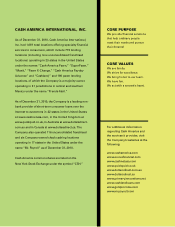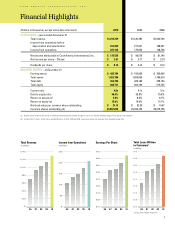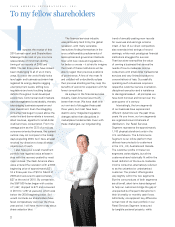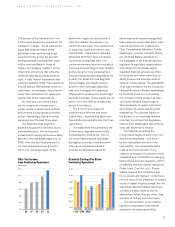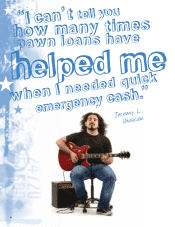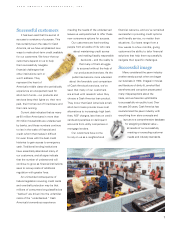Cash America 2010 Annual Report Download - page 7
Download and view the complete annual report
Please find page 7 of the 2010 Cash America annual report below. You can navigate through the pages in the report by either clicking on the pages listed below, or by using the keyword search tool below to find specific information within the annual report.
100 percent of the loan portfolio in our
E-Commerce Segment is unsecured. An
intelligent “outsider” would instinctively
argue that collateral makes all the
difference in the world during tough
economic times. Surely, the secured
lending business would perform better
and be more profitable in times of
trouble. An intelligent “insider,” on the
other hand, will tell you that while the
collateral may help you sleep better at
night, it really doesn’t dramatically alter
customer behavior. What I have learned in
over 25 years in this business is that our
customers – by and large – fully intend to
honor their commitment for repayment
just as most prime customers do.
So intuitively, you would expect
the two segments to experience
similar trends in demand and portfolio
performance during various economic
cycles. Interestingly, that is not what
happened over the past three years.
Our Retail Services Segment
experienced growth in demand, but at
a moderating level. We had become
accustomed to seeing same store asset
growth in the high single digits prior to
2008. Over this last three-year period,
we have experienced loan growth in
the low to mid single digits. At the
same time – again counterintuitive to
what the outsider may expect – our
customers have been more determined
to repay their loans and redeem their
merchandise. This dynamic reflects a
behavioral shift that I have mentioned
in previous writings and talks. Our
customers became more anxious about
their jobs and providing for their families,
so they became more conservative in
their borrowing and spending habits. As
a result, the Retail Services Segment
enjoyed stable and steady revenue
growth in the mid single digits that
was then leveraged with operating
efficiencies to produce low double-digit
earnings increases. These results are not
bad for the most difficult recessionary
period in our history.
The E-Commerce Segment
experienced a different and more
volatile fate…experiencing significant
downdrafts and updrafts over the three-
year period.
The headwinds encountered by the
E-Commerce Segment were mostly
orchestrated by political fiat. One of
the most frightening and potentially
damaging outcomes of any economic
crisis is the unfettered license it
provides to ideological zealots for
advancing social engineering agendas
that prosperity would never allow. Such
was the development in places like
Ohio, Pennsylvania, Maryland, Florida,
Washington, Arizona, Colorado, Illinois,
etc. All these states capitalized on
the scapegoat of lax financial services
regulation (a significant misperception
with respect to the already highly
regulated financial services we offer)
to introduce new rules restricting our
ability to serve the financial needs of
citizens in those states. The granddaddy
of all was intended to be the Consumer
Financial Protection Bureau established
by the Dodd-Frank Act. Fortunately,
the formation of this bureau has been
sufficiently delayed long enough to
allow prosperity to regain momentum
and temper the public zeal for social
engineering. The ultimate impact of
the Bureau on our business remains
uncertain, but at least the aggressive
rhetoric from Washington has softened
since last November’s election.
The tailwinds propelling the
E-Commerce Segment stem from two
distinct developments…one driven
by the marketplace and one of our
own making. The marketplace factor
finds us as the beneficiary of the
massive contraction of consumer credit
unleashed by a combination of changing
bank policies and new regulatory reform
of federally insured financial institutions
(Dodd-Frank, Card Act, etc.). Simply
stated, I believe this contraction has
forced previously “banked” consumers
into the ranks of the unbanked. In today’s
world of instant fingertip access, the first
step these disenfranchised customers
will take is a step online to look for
alternatives. When they go online, they
are likely to find us, and many have.
The second factor, of our making,
has been a successful international
expansion campaign generating
$1.20
$1.00
$0.80
$0.60
$0.40
$0.20
$0.0
10
Q -1 Q -2 Q -3 Q -4
08 09
Quarterly Earnings Per Share
Continuing Operations
$120
$100
$80
$60
$40
$20
$0
After-Tax Income
from Continuing Operations
(in millions)
1006 07 08 09
3




